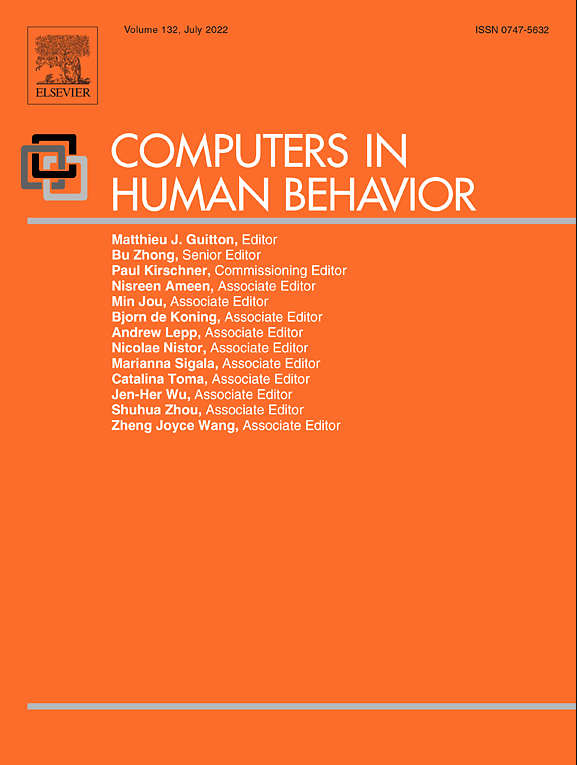Editorial Board / Publication information
Quantifying engagement: Measuring player involvement in human–avatar interactions
Simultaneously presented animations facilitate the learning of higher-order relationships
Facebook: Social uses and anxiety
Psychosocial functions of social media usage in a disaster situation: A multi-methodological approach
Differences in intrapersonal and interactional empowerment between lurkers and posters in health-related online support communities
The relationship between life stress and smartphone addiction on taiwanese university student: A mediation model of learning self-Efficacy and social self-Efficacy
Conversations with a virtual human: Synthetic emotions and human responses
Memory abilities in action video game players
Misery rarely gets company: The influence of emotional bandwidth on supportive communication on Facebook
Online communication and subjective well-being in Chinese college students: The mediating role of shyness and social self-efficacy
Using modern technology to keep in touch with back burners: An investment model analysis
Exploring how perceived threat and self-efficacy contribute to college students’ use and perceptions of online mental health resources
Completion rates and non-response error in online surveys: Comparing sweepstakes and pre-paid cash incentives in studies of online behavior
Exploring users’ social responses to computer counseling interviewers’ behavior
How political candidates use Twitter and the impact on votes
Antecedents and consequences of perceived value in Mobile Government continuance use: An empirical research in China
An experimental study of online chatting and notetaking techniques on college students’ cognitive learning from a lecture
Does country context matter? Investigating the predictors of teen sexting across Europe
Low self-control and cybercrime: Exploring the utility of the general theory of crime beyond digital piracy
Student perceptions of Science, Technology, Engineering and Mathematics (STEM) content and careers
Letter repetitions in computer-mediated communication: A unique link between spoken and online language
Another brick in the Facebook wall – How personality traits relate to the content of status updates
A snapshot of the first encounters of visually disabled users with the Web
Avatar creation in virtual worlds: Behaviors and motivations
“I Have AIDS”: Content analysis of postings in HIV/AIDS support group on a Chinese microblog
User experience and personal innovativeness: An empirical study on the Enterprise Resource Planning systems
Predicting guild commitment in World of Warcraft with the investment model of commitment
Spatial augmented reality as a method for a mobile robot to communicate intended movement
Son, you’re smoking on Facebook! College students’ disclosures on social networking sites as indicators of real-life risk behaviors
Consumer attitudes toward blogger’s sponsored recommendations and purchase intention: The effect of sponsorship type, product type, and brand awareness
Constantly connected – The effects of smart-devices on mental health
Neurophysiological correlates of cognitive absorption in an enactive training context
Depression, loneliness and Internet addiction: How important is low self-control?
Prediction of cyberslacking when employees are working away from the office
When technology acceptance models won’t work: Non-significant intention-behavior effects
Behavioral intention, use behavior and the acceptance of electronic learning systems: Differences between higher education and lifelong learning
Predicting teachers’ generative and receptive use of an educational portal by intention, attitude and self-reported use
Toward an understanding of the behavioral intention to use a social networking site: An extension of task-technology fit to social-technology fit
Non-significant intention–behavior effects in educational technology acceptance: A case of competing cognitive scripts?
Participation in virtual academic communities of practice under the influence of technology acceptance and community factors. A learning analytics application
An e-maturity analysis explains intention–behavior disjunctions in technology adoption in UK schools
Corrigendum to “Computerized working memory training: Can it lead to gains in cognitive skills in students?” [Comput. Hum. Behav. 29 (2012) 632–638]
Corrigendum to “Discrepant gender patterns for cyberbullying and traditional bullying – An analysis of Swedish adolescent data” [Comput. Hum. Behav. 29 (2013) 1896–1903]

